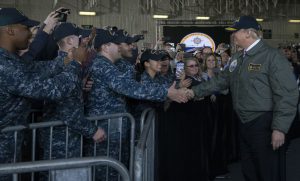 President Trump can get a 350-ship fleet by the next election. Back in November 2016, I sketched out a rapid path for 350 ships. It was built around my central thesis–that the Navy and New SECNAV had to be near to 350 by 2020.
President Trump can get a 350-ship fleet by the next election. Back in November 2016, I sketched out a rapid path for 350 ships. It was built around my central thesis–that the Navy and New SECNAV had to be near to 350 by 2020.
There’s still a lot of folks-who-should-know-better who believe President Trump’s promise meant that America had decades to get to a fleet of 350. Any advocates for that path haven’t done a single bit of research on President Trump or his preference for quick execution.
THE NAVY HAS ONLY THREE YEARS.
The best the Navy can hope for is to lash a sensible, long-term 350-ship plan with a far faster, “80% solution” set of 350 by 2020. If the Navy can’t get to 350 by 2020, it won’t get a longer-term expansion plan.
My plan focused on: 1) Raiding the Reserves; 2) Reclassify; 3) Buy some Boats; 4) Tap the National Fleet; 5) Speed up the Pipeline; and 6) Stop Decommissionings.
As part of what will be a regular feature, let’s check in and see how we’re doing, starting from today’s Naval Vessel Register Ship Battle Force size of 276.
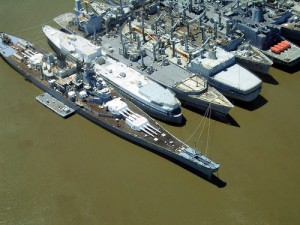 Raiding the Reserves:
Raiding the Reserves:
From the article traffic over the past few weeks, it appears the Navy is reviewing any and all reserve ships for potential reactivation. That’s good, and I support any and all studies on the fate of older, potentially second-string warships.
Again, as I said earlier, the ships in true “mothballs” stand the greatest chance of reactivation–and that will mean the Navy might get from two to maybe five total ships from this source (two T-AOEs and–if we stretch, three LHAs and a CV). Jerry Hendrix and Robert C. O’Brien have urged reactivation of combatants that haven’t been preserved in the reserve fleet. We might–might–get eight frigates out of this, but I have my doubts. I will drop the LHAs and hold at (+2). [Fleet Size 278]
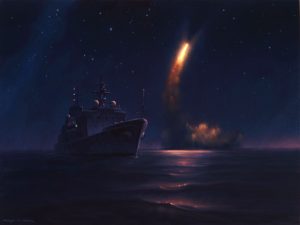 Reclassify:
Reclassify:
This is where we will see real action. Nobody noticed the March announcement of Task Force Ocean and the CNO’s quiet visit to an Oceanographic Survey Ship in April. There are six T-AGSs in the fleet, and the USNS Bowditch (T-AGS 62) has a record of conflict with PLA(N) ships that a combatant can only dream about. Look to see these ships be added to the Combat Fleet, serving as UUV tenders or something. (+6)
I expect the thirteen PC-1 Patrol Boats to be counted in the battle fleet, but, as this will require an act of Congress, it’ll take time. Senator McCain won’t like it, but since when has the Congress stood between President Trump and one of this policy goals? (+13) [Fleet Size 297]
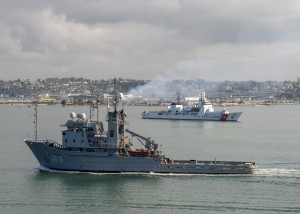 Buy Some Boats:
Buy Some Boats:
No real progress has been made in this area. But if the USS Fitzgerald incident is any indicator, it suggests the Navy really needs deepwater-ready salvage and recovery ships. What would have happened if the Fitz was holed somewhere farther from help? I mean, harbor tugs are great, but, if we are building survivable vessels and sending them into harms way (with inattentive or overtasked or undertrained crews, ahem), America needs more all-weather salvage/rescue/recovery ships. History has shown that these ships are enormously useful, and, as long as oil is cheap, a relevant production run of well-maintained utility ships should be bought up, painted grey, and put to work as a backstop the yet-t0-be-contracted T-ARS(X) Class. (+10) [Fleet Size 307]
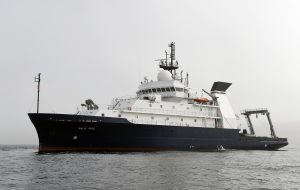 Tap the National Fleet:
Tap the National Fleet:
This is where the action is gonna be. We’re already seeing a lot of work going into identifying duplicative government services, and the balkanized National Fleet, split between a bewildering number of agencies, is sort of sitting there, exposed to budget cutters.
With the National Fleet ripe for rationalization, it would be smart for all parties to sit down with the Navy now, quietly, and determine how they can conspire to keep as much mission capability as they can in a cost-effective way.
I talked about the possibility of the Navy taking over some of the larger USCG fleet units back in November, but I have a few other suggestions:
Make the oceanographic fleet part of the Navy. The acquisition of oceanographic data has been on the front line of maritime conflict–as the Bowditch, Impeccable and other incidents have demonstrated. The Navy is a robust consumer of of oceanographic information and a resource driver in the race to exploit unmanned platforms, sensors and big ocean data, and this area of “big ocean science”, I expect, will be the next area of contest with the Chinese Navy. The recent spotting of a new Impeccable-like ship in a Chinese shipyard this week and some deliberate Chinese research off Guam only confirms that leadership in National Security-relevant Ocean Sciences is on the agenda.
So, what can we do? Well, given that the Navy already builds and owns T-AGOR platforms (and I assume, the design) used for the research fleets, it makes sense to add the sixteen ships in the NOAA Fleet to the U.S. Navy. These can–if the NOAA and the Navy are able to agree on how to manage NOAA’s collaborative civilian research work–be absorbed into Task Force Ocean. Out of that, NOAA will get access to some really interesting gear and possibly some info that it might not obtain via it’s existing fleet structure, while the Navy will get to ensure the rationalization of the research fleet while guaranteeing that critical oceanographic data for the deep Pacific and elsewhere will continue to be collected without interruption. (+16)
In the process, the Navy should absorb the larger Navy-owned vessels at the University National Oceanographic Laboratory System (UNOLS). Take the large ships owned by the likes of the Woods Hole Oceanographic Institution, Scripps, and Washington State and put ’em in the fleet. This step allows President Trump to demonstrate his commitment to the Navy while also suggesting that he’s being tough on those pesky climate control research folks. In the meantime, the Navy can help rationalize the design features for follow-on vessels while getting the oceanographic support it needs for future operations. The Navy even gets access to a little icebreaker, too. (+13 at least)
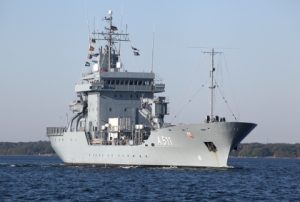 Place the Training Academy Fleet into the Navy. There are seven maritime academies in the United States, and America desperately need mariners. Place their training ships (an odd-lot set of ships that are ready for retirement) into the Navy, and then take MARAD’s National Security Multi-Mission Vessel (NSMV) Program away from that festering sore of an agency (That said, I have high hopes for the current Administrator Mark “Buz” Buzby–he rocks!), and move out smartly. For those that don’t know, the NSMV program would attempt to leverage the maritime academies for national emergencies by providing them with vessels capable of offering some simple disaster support resources (i.e. helo flight decks, command and control, medical support, ro-ro/amphib)–like a small Damen 16000 logistic support vessel, or MRAV or something like that. This would be a great way to get a good handful of handy-size support craft (the ships that are really useful militarily, but can’t pass muster with modern-day military accountants) into national service. These would be perfect ships for Philly Shipyard to build, the states would love it and it would all fit into President Trump’s wider efforts to rebuild the American workforce (+7).
Place the Training Academy Fleet into the Navy. There are seven maritime academies in the United States, and America desperately need mariners. Place their training ships (an odd-lot set of ships that are ready for retirement) into the Navy, and then take MARAD’s National Security Multi-Mission Vessel (NSMV) Program away from that festering sore of an agency (That said, I have high hopes for the current Administrator Mark “Buz” Buzby–he rocks!), and move out smartly. For those that don’t know, the NSMV program would attempt to leverage the maritime academies for national emergencies by providing them with vessels capable of offering some simple disaster support resources (i.e. helo flight decks, command and control, medical support, ro-ro/amphib)–like a small Damen 16000 logistic support vessel, or MRAV or something like that. This would be a great way to get a good handful of handy-size support craft (the ships that are really useful militarily, but can’t pass muster with modern-day military accountants) into national service. These would be perfect ships for Philly Shipyard to build, the states would love it and it would all fit into President Trump’s wider efforts to rebuild the American workforce (+7).
I won’t say anything about transferring platforms from the USCG to the USN, but adding modestly-refreshed FFG-7 Frigates to serve in an EEZ patrol role would be a great help, doing a lot of good in meeting long-forgotten USCG patrol goals last articulated WAAAAY back in the Deepwater era. [Fleet Size 343]
Speed Up the Pipeline:
I see a lot of talk here, but nothing concrete has emerged yet–the “wholeness” budget wasn’t helpful with regards to numbers, but improving readiness is a critical thing. As I said last time, we’ve got at least 25 ships in various stages of production and about nine set for delivery well before the election. (+9) [Fleet Size 352]
Stop Decommissionings:
No change here. No surface ships are slated for decommissioning (4 tugs and salvors plus the LSD Pence) and we’ll lose some subs.
Conclusion:
The 350-ship Navy is within sight.
Not only that, it’s looking like an increasingly easy lift. Most of these hybrids that enter the fleet from other agencies can adopt to the MSC pretty easily.
It might just work. With some adept management of the narrative, using the high-tech militarily-necessary “oceanographic support” arms race approach to get to 350 ships would be a pretty neat solution for a pretty ambitious campaign promise.
